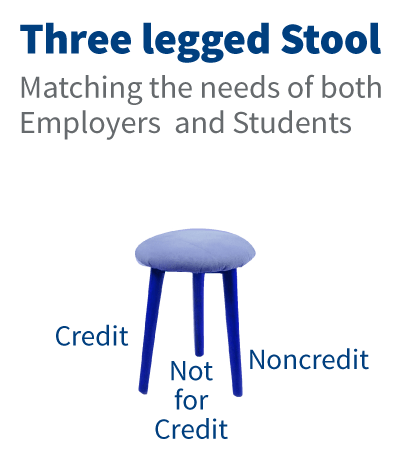
Back to Contract Education Toolkit
![]()
Contract Education
Matching the needs of both Employers and Students
1 See – Contract Ed TOOL KIT _2017.pdf
2 See – National CE Survey Report 2017.pdf
A. What Is Contract Education?1
-
-
- Delivery System of Training and Services
- Single Point of Contact for Business & Employers
- Cost Recovery Units
- Not-for-credit Customized Solutions
- Credit and Noncredit Programs
- Performance Improvement
- Flexible, Rapid Response Delivery
-

Credit and Noncredit
-
-
- Both receive apportionment from the State Chancellor’s Office
- Both follow the college / district curriculum process
- Credit has the advantage of transferability and credibility
- Noncredit has the advantage of affordability and repeatability
- Neither can be developed and implemented particularly fast
-
Not-for-Credit and Contract Education
-
-
- Allowed by Ed. Code
- But does not receive apportionment from the State Chancellor’s Office
- Someone else is paying for it
- Can be customized to meet the employers’ or client’s immediate needs
- Can be developed and implemented quickly
- Can be modified on the fly
- Can now be funded by SWP 5.0+
- Can now be funded through an Employment Training Panel
-
Short-term workforce training is a recognition that, frequently, colleges’ curriculum approval processes may delay the ability to address existing job openings with targeted training. By its nature, short-term workforce training provided utilizing SWP funds will be focused on specific job skills needs of employers. Short-term workforce training programs must have at least one proven employer partner, demonstrate job vacancies, and submit verification to the Chancellor’s office including the number or individuals served, completion rates, and placement rates.
Community College Funding Pilot Partnership
-
-
- ETP reimburses based on a per training hour basis
- $14 -$16 per training hour
- Minimum of 8 hours and maximum of 200 hours
- Must Earn Minimum ETP Wage
- $19.12 per hour (can count $2.50 in benefits)
- ETP is performance-based
- Must stay employed 90 days after training to earn reimbursement
- ETP reimburses based on a per training hour basis
-
ETP – California Community College Funding (CCCF) Pilot
-
-
- Can now be used for nonprofits, municipalities, public safety departments, education, and public agencies
- If interested reach out to John Milburn at College of the Canyons or Dave Teasdale.
-
Short-term Training and Contract Education
-
-
- Most commonly referred to as “Contract Ed”
- We like to look at it in two ways:
- A way to meet the very specific training needs of an industry partner which does not match our course delivery or curriculum development schedule
- The Research and Development branch of the college
- Contract Ed is a great way to keep Industry Partners engaged
-
Contract Education as R & D
-
-
- College of the Canyons Facilities Management certificate
- Launch as Contract Ed while certificate is being developed and taken through the curriculum approval.
- IFMA (industry association) says there is a lot of demand. Class can be piloted as proof of concept.
- Pilot can inform Credit and Noncredit version.
- College of the Canyons Facilities Management certificate
-
Contract Education As Employer Engagement
-
-
- By being able to quickly pivot to offering a requested training, employers view the college as a solution to their incumbent worker training needs.
- Traditional curriculum approval takes too long
- Benefits of being viewed as solutions provider and partner:
-
- More enthusiasm for participation in advisories
- More enthusiasm for discussing job placements and internships
- Greater willingness to provide letters of support for grants
-
- By being able to quickly pivot to offering a requested training, employers view the college as a solution to their incumbent worker training needs.
-
B. Benefits1
-
-
- Increased discretionary revenue
- Greater community visibility
- Employer participation beyond contracting
- Strategic alliances
- Increased access to students
- Faculty professional development
- Curriculum development – beta testing
-
C. Challenges1
-
-
- Regulatory relief
- Institutional support
- Internal processes that support service delivery
- Turnover in staff
- Evolving institutional role for contract education
- Economic development infrastructure
- Incentives for doing economic development
- Marketing and market share
-
D. California Education Code 78020-780231
CALIFORNIA CODES
EDUCATION CODE
SECTION 78020-78023
78020. For purposes of this article:
(a) “Contract Education” means those situations in which a community college district contracts with a public or private entity for the purposes of providing instruction or services or both by the community college.
(b) “Credit” refers to any class offered for community college credit, regardless of whether the class generates state apportionments.
(c) “Noncredit” refers to courses that meet the criteria for apportionment pursuant to Section 84757.
(d) “Not-for-credit” refers to classes, including community services classes, that are offered without credit and that are not eligible for apportionments pursuant to Section 84757.
78021.
(a) The governing board of any community college district may establish, or with one or more community college districts may establish, contract education programs within or outside the state by agreement with any public or private agency, corporation, association, or any other person or body, to provide specific educational programs or training to meet the specific needs of these bodies.
(b) The contracting community college district or districts shall recover, from all revenue sources, including, but not necessarily limited to, public and private sources, or any combination thereof, an amount equal to, but not less than, the actual costs, including administrative costs, incurred in providing these programs or training.
(c) The attendance of students in these contract education programs shall not be included for purposes of calculating the Full-Time Equivalent Students (FTES) for apportionments to these districts, unless all statutory and regulatory conditions for generating FTES are met.
78022.
(a) Faculty in all credit and noncredit contract education classes shall be selected and hired according to procedures existing in a community college district for the selection of instructors for credit classes.
(b) Faculty teaching credit and noncredit contract education classes shall be compensated in the same manner as comparable faculty in the regular, noncontract education program. This subdivision does not apply to faculty teaching in contract education programs conducted outside California for the United States armed forces, unless the faculty member is covered by a collective bargaining agreement.
(c) Faculty teaching credit or noncredit contract education classes shall be evaluated according to the procedures used for the evaluation of faculty in the regular, noncontract education program.
(d) Faculty teaching not-for-credit contract education classes shall be compensated in the same manner as faculty in the regular, noncontract education program if the course meets the same standards as a course in the credit curriculum. This subdivision does not apply to faculty teaching in contract education programs conducted outside California for the United States armed forces, unless the faculty member is covered by a collective bargaining agreement.
(e) Faculty teaching not-for-credit contract educational programs shall be evaluated according to procedures specified in the contract between the community college district and the public or private entity to establish the program.
(f) This section shall not be construed to restrict the appearance of guest lecturers in any programs or classes operated by a community college district.
78023.
(a) Nonprofit public benefit corporations that are not organized as auxiliary organizations pursuant to Article 6 (commencing with Section 72670) of Chapter 6 of Part 45 and are conducting contract education programs shall not use the name of a community college district or of a college of a community college district.
(b) A nonprofit public benefit corporation that is not organized as an auxiliary organization pursuant to Article 6 (commencing with Section 72670) of Chapter 6 of Part 45 and is conducting contract education programs shall not employ the resources and staff of a community college district without full compensation for all related costs.
E. Contract Education Program Models1
California Community Colleges Contract Education Program Models –
Several ways to organize your unit

1. Program Developer Model
Each person (manager) is responsible for generating business, follow-through with leads, contacts with clients, arranging for or conducting up-front business needs analysis known as Front-End Analysis (FEA), identifying business need based on business goals and results of FEA, identifying possible training and/or non-training solutions, bringing in appropriate subject matter expertise, negotiating and developing contracts with client and service providers (instructors, Workforce and Economic Development Division (WEDD), or vendors), scheduling, maintaining contact with client, providing customer service and follow-through, evaluation, and invoicing functions.
This is currently the model used most in contract education units. There is frequently more than one Program Developer in a college unit.
Advantages: Strong relationship building; one point of contact for client; less likelihood for miscommunication or problems to go unnoticed.
Disadvantages: More time consuming for Program Developer; less time for leads and new client development; need for staff with many competencies (see Competencies for Contract Education Professionals).
2. Sales Model
Salespeople generate business, may conduct or arrange for FEA, hands off to a program developer for proposal development, delivers proposal to client, “makes the sale” and then hands off to a program developer or subject matter expert to follow through. Program developer then develops the relationship, develops subcontracts with service providers (instructors, centers, vendors), scheduling, maintaining most of the contact with client, providing customer service and follow-through, evaluation and invoicing functions. Works best with performance based pay and incentives as well as profiled/targeted hiring practices.
Advantages: Less time with each client; more time for leads development; possibility for more sales; salesperson focused primarily on sales; incentives for performance.
Disadvantages: More opportunities for miscommunication; hand offs, roles and responsibilities need to be clearly defined; less relationship building; more than one contact for client; need for two types of skilled staff – sales & program developer.
This model is currently used in only a few contract education units. It is difficult to “sell” services offered through our contract education and EWD centers since most of it is intangible to the client. Incentives can be challenging to implement within our community college cultures and organizations.
3. Contract Administration Model
This would take contract administration out of the Program Developer model and could be used with the Sales model as well. The contract administrator would handle all of the details of the contracts including signatures, invoicing, time sheets and payment for services provided. Day-to-day operations and oversight such as scheduling, materials, instructors, follow-through, evaluation, etc. are handled by the program/project manager, often the subject matter expert.
Advantages: Takes some of the day-to-day contract administration out of the responsibility of the program manager; allows more time for program manager to develop new business and provide customer service; one person dealing with business office and internal processes.
Disadvantages: More than one contact for client; somewhat unclear definition of roles; additional staff necessary; responsibilities somewhat blurred; highly dependent on college culture and infrastructure.
This model is used in a few colleges that have multiple subject matter departments, centers or strong specialists in a given topical area. The subject matter experts focus on their area of strength while the detail work and internal processes are facilitated by another manager who works closely with them. It has only proven to work where there is an organizational structure and culture that shares resources and recognition. “Centers” are not the focus but rather the college and economic development unit are key focal points.
Note: In each of these models if there is more than one program manager or more than one salesperson, it is necessary for the unit to clearly define and divide client base within the College or District service area. This can be done either by territory (city, county, region, etc.) or by industry (retail, manufacturing, service, transportation, etc.). Some divide their unit and various center’s participation by subject or program being delivered (computer based, basic skills, technical skills, ESL, etc.) though they almost always organize operationally within one of the three models listed above. It is not recommended to divide by size of business as needs are universal across size. Staff should also be assigned specific professional organizations to attend on a regular basis.
F. Questions for Developing a Contract Education Program1
1. What is the business base and potential for contracts?
2. What are the marketing opportunities? What are the available resources?
3. How do the President and Chancellor show their support for this activity?
4. What is the commitment of resources to support the operation?
5. Who will the program report to? How does this next level of supervision demonstrate support for the program?
6. Who will be the program manager? What is the time commitment?
7. What is the level of authority to act?
8. What strong programs are available for delivery to business? Is staff (instructional) available to deliver them?
9. Are human resources and business processes sufficiently flexible to be responsive to business needs?
10. Is there willingness to improve processes, remove barriers, or add resources if necessary to deliver flexible, responsive programs to business?
11. What is the level of understanding/support from faculty for the program?
12. Are there any internal champions for the program?
13. What learning needs exist for those carrying out or supervising the program?
14. If staff are already assigned, is there anything that you feel they should be doing more, better or differently?
G. Guidelines For Contract Ed CA. Community Colleges1
The information below is intended as a guideline to offering contract education through a community college.
1. A California community college may contract with a public or private entity, corporation, association, person or body, for the purposes of providing instruction, services, or both, by the College. This is contract education.
Ed Code §78021(a)
2. Students can earn unit credits and, when applicable, receive certificates and degrees for work completed through contract education.
California Code of Regulations, Title 5, §55170
3. The college can charge for the actual cost of the program, to include instruction, materials, books, administrative costs and any other costs necessary to conduct the program. The cost of instruction could vary by college and by programs.
Ed Code §78021(b)
4. There is no set fee for administrative costs. That fee will be based on the program/training desired. The party contracting for the instruction or services must sign an agreement, which will outline the instruction/training to be provided, along with all costs necessary to provide the instruction/training.
5. Student enrollment fees do not apply to a contract education program if the entire cost of a course, including administrative costs, is paid by a public or private agency, corporation, or association with which the District contracts.
Ed Code §76300 (e) (3)
6. Attendance of students in contract education programs shall not be included for purposes of calculating the FTES for apportionment to the District.
Ed Code §78021(c)
7. Courses that are fully paid for by an employer do not need to be open to the public.
8. Faculty teaching credit and noncredit contract education classes shall be compensated in the same manner as comparable faculty in the regular, noncontract education program. Faculty teaching not-for-credit contract education classes shall be compensated in the same manner as faculty in the regular, noncontract education program if the course meets the same standards as a course in the credit curriculum.
Ed Code § 78022 (b) and (d)
H. Conducting Contract Education for Credit and Apportionment1
The customary and usual practice in contract education programs includes funding from external companies, businesses or agencies and training that does not include college degree credit. This arrangement provides maximal flexibility, custom design and expedient delivery. Therefore, contract education has the client friendly ability to meet the current and emerging training needs of a broad array of labor market stakeholders including employers and employees.

However, there are internal and external factors that may suggest that a contract education program seek to secure funding from the regular state funding mechanism (apportionment), and/or provide college degree/certificate applicable credit for a particular course or courses. These factors can include a desire to provide students/employees with a permanent college record of their training, training that carries accredited status, the desire to assist in helping the college meet its enrollment goals and/or the desire to secure state funding for the program. Another consideration in terms of participating in the credit course and revenue processes of the college, is the opportunity to increase the degree of integration and recognition for contract education. CE is best seen as an important and valuable function of the college in its attempt to meet the workforce needs of its community along with the advantages of cost and revenue sharing.
Some useful definitions:
a) Credit Course – any course that has been formally approved by a college, is listed in their catalog, applies to a degree or certificate program and results in an evaluative grade. Completion of this course is permanently recorded on the student’s college transcript.
b) Non-degree Applicable Credit Course – as above except does not apply to any associate degree. Designed to enable students to succeed in degree applicable courses, provide foundation skills for CTE degree programs, or essential technical instruction where degree applicable credit course standards are neither necessary or required. Completion of this course is permanently recorded on the student’s college transcript.
c) Non-Credit Course – any course that has been formally approved by a college, is listed in their catalog, does not apply to a degree or certificate program and usually results in a pass/no pass grade. Completion of this course is permanently recorded on the student’s college transcript.
d) Not for Credit Course – any course or activity provided by the college that does not meet statutory requirements for course approval, typically is non-graded, does not apply to any certificate or degree program and does not result in permanent transcript record. These courses/activities are usually offered through community or contract education and are not eligible for state funding.
e) Apportionment – funding provided by the State of California that is formula driven and based on the number of Weekly Student Contact Hours (WSCH) completed by students enrolled in Credit or Non-Credit Courses. WSCH is converted to a Full-Time Equivalent Student (FTES) number. Each college district has an assigned FTES revenue rate, generally around $4,750 per FTES for Credit Courses and a lower rate for Non-Credit Courses. Different formulas apply to semester versus quarter term colleges.
Receiving State Funding (Apportionment)
For a college to receive apportionment for instruction:
a) The course must be a “credit course” (i.e. degree applicable credit, non-degree applicable credit or noncredit course).
b) Students enrolled must complete the regular registration processes of the college. There are usually modified registration requirements for students only taking one class in a given term. This does have some additional benefits to students such as access to campus facilities and services, use of the library, open computer labs, enrollment in other vocational and recreational classes, etc.
c) Generally, the course must be open to all registered students, i.e. open access.
However, there are some important exceptions to this general rule:
i. Courses may have prerequisites or corequisites (Title 5, Section 55003)
ii. Limiting enrollment to a cohort of students enrolled together in one or more classes
(Title 5, Section 58106, Sec. B, Para.4)
Standards for Credit Courses
The standards for a credit class are detailed in Section 55002 of Title 5. However, for the Contract Education Director, the key is finding a course to use that is currently in the college catalog, since this listing verifies that all standards for approval have been met. Grading standards also listed in 55002 warrant attention.
Working with relevant CTE programs to help develop new courses that meet both program and training needs is a worthwhile, if at times challenging, activity. It is another way contract education can integrate and be recognized as the important function it is for the college and its stakeholders.
This tool kit was prepared by the Learning Resources Network (LERN) team of Greg Marsello, LERN’s co-founder and Senior Vice President; Rodney Holt, Associate Dean of the School of Continuing Education at Red Deer College in Red Deer, Alberta; and Julia King Tamang, LERN’s Senior Consultant for contract education. All three are foremost contract education subject matter experts. Additional input was provided by a group of seasoned and freshmen California Community College Contract Education practitioners.
Art work credits:
vecteezy_abstract-certificate-icon-illustration, vecteezy_13-27, Seo_And_Digital_Marketing_21-40, vecteezy_modern-light-bulb-idea-logo-icon-template-simple-minimal, vector60-1040-01, illust58-3612, vecteezy_industry-4-0-concept-smart-factory-with-business-icon-vector-eps10_687575, vecteezy_vector-of-50-education-and-school-subject-bicolor-solid-glyph-icon_2087555, pexels-mochammad-algi-3739994, pexels-sora-shimazaki-5668526, pxl-pixabay-257636, pxl-pixabay-207489, pexels-artem-podrez-5726800, pexels-kateryna-babaieva-2760242, pexels-mark-stebnicki-2255801, pexels-olya-kobruseva-8177922, pxl-kampus-production-5940706, pexels-karina-zhukovskaya-6446710.
